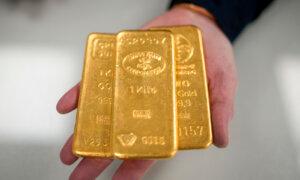Those struggling as their dollars lose value to inflation may be pleased to know that many states are now working to pass laws that would allow gold and silver to be used—not only for savings and investment but as everyday currency for purchases and payments as well.
The state of Utah took a major step last week toward the use of gold and silver as transactional currencies, allowing their use for state payments to vendors. A bill sponsored by state Rep. Ken Ivory passed the Utah state Legislature on March 18 and is now awaiting the signature of Gov. Spencer Cox.
If it is signed, Utah will be the first state to pass a “transactional gold” bill.
“This is about making sure that people have choices,” Ivory told The Epoch Times. “It’s important that we give people a choice in how they store and transact their earnings and their savings.”
For Utah residents, the bill also addressed issues of local autonomy and preservation of savings, he said.
“We express our liberty and our work and our property in something called money, but where the dollar used to be money, now it’s just currency,” he said. “I think people want to see their earnings and property be reflected in real money again.”
Money functions as a medium of exchange, a unit of account, and a store of value. But the dollar has struggled to hold its value since it was delinked from gold.
A Growing Movement to Use Gold as Money
State lawmakers believe they are on firm legal footing in establishing an alternative legal tender. While the U.S. Constitution gives the federal government the exclusive right to “coin money,” it also permits states to make “gold and silver coin a tender in payment of debts.”Utah is far from alone in this effort. Many other states are also working to accept gold as currency.
According to Kevin Freeman, author of “Pirate Money” and a longstanding advocate for using gold as legal tender, the movement by states to legislate transactional gold has gained significant traction over the past several years.
“Now, 25 states have looked at this, and we’re getting even some traditionally blue states that are demonstrating interest,” Freeman told The Epoch Times. “We’ve picked up bipartisan support, and so my optimism is quite high.”

History on Their Side
Gold functioned as money throughout the United States until the federal government intervened to force the transition to what ultimately became a fiat currency.When the Great Depression hit in 1929, “people hoarded gold instead of depositing it in banks, which created an international gold shortage,” Hasenstab wrote.
“Countries around the world basically ran out of supply and were forced off the gold standard,” she wrote.
A shortage of money caused prices to decline in the 1930s, causing the crisis to escalate. Farmers, for example, could no longer earn enough for their crops to repay bank loans, leading to defaults and the failure of many local banks.
This ended the use of gold for domestic transactions in the United States.
Dollars Not Holding Value
However, Americans have experienced a dramatic erosion in the value of their money under the fiat currency system. Since Nixon took the dollar off the gold standard in 1971, the U.S. dollar has suffered a cumulative inflation of 688 percent.“In 1971, you could buy a house for $20,000 in Salt Lake, or 563 ounces of gold,” Ivory said. “Today, the average house is pushing $600,000, but with 563 ounces of gold, you can buy more than three houses.
“Houses aren’t more expensive; they’re less expensive than ever on a fixed standard,” he said. “But our dollar has become this illusory standard where we’ve got unelected people deciding what the inflation rate is, which means how much of our money they’re going to take every year.”
A number of other issues regarding the dollar, including federal debt and spending, could also erode people’s confidence that it can maintain its value as a fiat currency.
“Certainly as part of our working group, there was a lot of discussion around the impact of inflation, the impact of the amount of debt we have, and the erosion, potentially, of the reserve status of the dollar,” Oaks said. “With BRICS and other foreign entities trying to move away from the dollar, you’ve seen central banks accumulate physical gold.”
Spending Gold With a Debit Card
According to Freeman, one thing that is necessary for gold to become a commonly used transactional currency is a proliferation of companies such as Glint, which is based in the United Kingdom.Glint holds gold deposits and issues debit cards that allow depositors to spend their gold deposits in any amount and in multiple currencies. The company states on its website that it “offers an alternative to fiat currencies“ that enables its clients ”to buy, save, and spend allocated gold with the flexibility of Mastercard.”
“It’s really the result of technological advancements that enable fractional gold transactions as easy as using a debit card,” Oaks said. “The value [of gold deposits] is tracked for you, and you can transact in the economy with the card technology that we have.”
Although Freeman said he hopes that gold and silver will one day be widely available as a transactional currency, he also said he expects that this will be an alternative to, rather than a replacement for, the U.S. dollar.
“I don’t see it necessarily replacing the American dollar, unless the dollar were to fail,” he said.
“But money has changed a lot. Now, we have Tap to Pay and Venmo and Bitcoin and PayPal; this is just another way to pay.”







